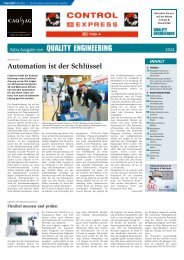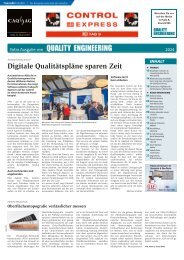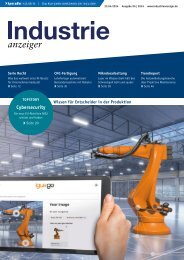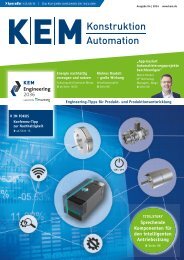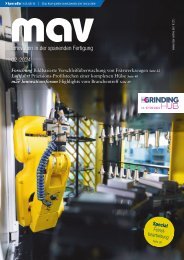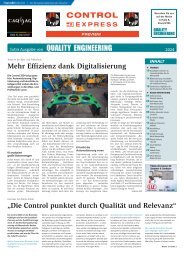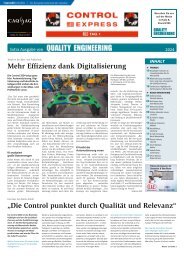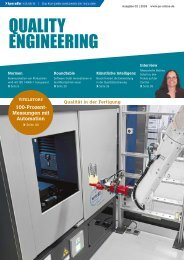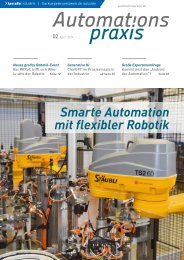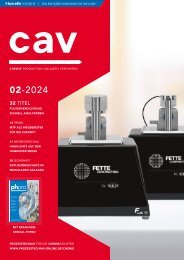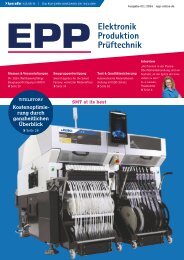cpp – Process technology for the chemical industry 02.2020
The journal cpp - Process technology for the chemical industry reports about processes, plants, apparatus and components for the chemical and pharmaceutical industry. Further topics are IT technologies, industry 4.0, digital production, MSR and automation technology and process analysis technology. The content spectrum is rounded off by explosion protection, plant safety, occupational health and safety, maintenance, site management and energy management.
The journal cpp - Process technology for the chemical industry reports about processes, plants, apparatus and components for the chemical and pharmaceutical industry. Further topics are IT technologies, industry 4.0, digital production, MSR and automation technology and process analysis technology. The content spectrum is rounded off by explosion protection, plant safety, occupational health and safety, maintenance, site management and energy management.
You also want an ePaper? Increase the reach of your titles
YUMPU automatically turns print PDFs into web optimized ePapers that Google loves.
Picture: Phoenix Contact<br />
Picture: Phoenix Contact<br />
With <strong>the</strong> NOA concept, field device data can be read out securely and impact-free, and<br />
<strong>for</strong>warded to a cloud, <strong>for</strong> example<br />
The I/O modules of <strong>the</strong> Axioline F product<br />
family with IP 20 degree of protection are<br />
also available <strong>for</strong> use in Ex i zones<br />
signals, o<strong>the</strong>r types of data can be read via<br />
Hart communication as a superimposed signal<br />
from field devices <strong>–</strong> irrespective of<br />
whe<strong>the</strong>r <strong>the</strong>y are sensors or actuators. Typically,<br />
Hart functions are only used <strong>for</strong> replacing<br />
devices in <strong>the</strong> field or workbench<br />
calibration <strong>–</strong> comparable to measuring<br />
pulse and blood pressure, which is only<br />
done during a visit to <strong>the</strong> doctor. But today<br />
<strong>the</strong>re are smartwatches that continuously<br />
log this type of in<strong>for</strong>mation and can graphically<br />
present it <strong>for</strong> an entire day. This capability<br />
is also desirable in industrial applications.<br />
Easily integrated<br />
Using special Hart I/O cards that can be integrated<br />
into process control engineering<br />
(PCE) or <strong>the</strong> distributed control system<br />
(DCS) <strong>for</strong> <strong>the</strong> purpose of using <strong>the</strong> Hart<br />
data generates additional costs. Since <strong>the</strong><br />
data are only of interest to maintenance personnel<br />
<strong>for</strong> device monitoring, Phoenix Contact<br />
has developed two solutions <strong>for</strong> Hart<br />
transmission that are used in <strong>the</strong> framework<br />
of a side channel. Both products can be integrated<br />
into existing and new process<br />
plants, and are continuously fur<strong>the</strong>r developed<br />
to meet <strong>the</strong> requirements of users and<br />
official bodies.<br />
The first approach is <strong>the</strong> modular E<strong>the</strong>rnet<br />
Hart multiplexer GW PL… bus. It provides<br />
<strong>the</strong> option of configuring and monitoring<br />
Hart devices via E<strong>the</strong>rnet. Hart devices can<br />
be integrated into almost any host system<br />
via industrial E<strong>the</strong>rnet systems such as<br />
Profinet, Modbus TCP, Hart IP, Emerson<br />
AMS, and OPC UA. The analogue control<br />
system remains fully operational and does<br />
not even need to be shut down <strong>for</strong> installation.<br />
An E<strong>the</strong>rnet Hart multiplexer consists<br />
of a head station and up to five four- or<br />
eight-channel Hart extension modules, so<br />
that a maximum of 40 Hart devices can be<br />
connected to <strong>the</strong> head station and supplied<br />
with current from it. The modular design<br />
provides a scalable solution <strong>for</strong> modern distributed<br />
control systems and phased rollouts.<br />
For four years, <strong>the</strong> E<strong>the</strong>rnet Hart<br />
multiplexer has been proving itself worldwide<br />
in smaller applications. It is ideal <strong>for</strong><br />
installation involving intrinsically safe applications<br />
and in combination with additional<br />
signal isolators on <strong>the</strong> Hart devices <strong>for</strong> Ex<br />
zone 2 applications.<br />
Adapted to harsh environments<br />
The second solution that was introduced at<br />
<strong>the</strong> Namur general meeting in November<br />
2019 is an extension to <strong>the</strong> proven Axioline<br />
F I/O system with IP 20 degree of protection.<br />
Axioline F features rapid signal acquisition.<br />
The robust mechanical system<br />
can withstand <strong>the</strong> harshest ambient conditions<br />
due to its excellent shock and vibration<br />
resistance. In addition, <strong>the</strong> extended<br />
temperature range from -40 to<br />
70 °C also contributes to an increase in system<br />
availability. And installation time is reduced,<br />
thanks to fast wiring without tools<br />
and easy handling. The I/O system has<br />
been extended to include analogue and<br />
digital input and output modules <strong>for</strong> Ex i<br />
applications. Now Axioline F can be used<br />
in both hybrid and continuous applications.<br />
It makes sense to install it where<br />
intrinsic safety is required but hot-swap capability<br />
is not necessary.<br />
The I/O modules can be coupled with <strong>the</strong><br />
industrial controllers and bus couplers in<br />
<strong>the</strong> Axioline product family. Users benefit<br />
from a solution that is less expensive than<br />
PCE/DCS, although <strong>the</strong> latter satisfies more<br />
rigorous requirements and offers PID control<br />
capability. However, Axioline F provides<br />
a reliable plat<strong>for</strong>m <strong>for</strong> maintaining<br />
process field devices that can flexibly adapt<br />
to specific general conditions and is subject<br />
to ongoing fur<strong>the</strong>r development. Alongside<br />
<strong>the</strong> standard I/O modules <strong>for</strong> Hart communication,<br />
<strong>the</strong> intrinsically safe variants<br />
open up new opportunities <strong>for</strong> use in <strong>the</strong><br />
field. Hart-compatible flow meters deliver<br />
additional selectable data, including device<br />
runtime, total flow rate, pressure and temperature.<br />
As a result, users can implement<br />
needs-based maintenance measures and<br />
optimise <strong>the</strong> relevant process. Since <strong>the</strong><br />
cost of <strong>the</strong> sensors installed in <strong>the</strong> process<br />
environment have become lower, Namur<br />
sensors can be monitored directly through<br />
<strong>the</strong> side channel as discrete signals.<br />
www.<strong>cpp</strong>-net.com<br />
Online search: Phoenix Contact<br />
AUTHOR:<br />
ARNOLD OFFNER<br />
Strategic Marketing Manager<br />
Automation Infrastructure,<br />
Phoenix Contact USA<br />
<strong>cpp</strong> 02-2020 43



